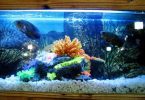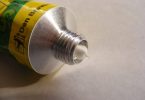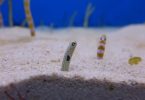Table of Contents
Guess what? This types of clown fish is actually too beautiful to be termed a clown. Like how could someone see a species of fish as beautiful as this and tag it a clown?
Whoever gave it that name needs some explanations. You will know why before you get to the end of this article, as long as you read attentively.
Did you know I thought the clownfish was actually a clown among fishes and would make the other fishes laugh or giggle.
Just like the starfish looks like a star and almost has the colour of the celestial, I thought the clown fish was going to be a clown among other species of fish when I finally learn of it or get to see it.
So the generic name of the clownfish is Amphiprion ocellaris. The clownfish belongs to the family of Pomacentridae, and is of the class of Actinopterygii.
This beautiful marine based creature is identified by its bright orange colour with three white bands on the head, the body and tail region.
The lifespan of a clownfish is about fifteen years (15yrs) in the wildlife or the natural habitat, and about three to five years (3- 5years) in captivity.
The life span of the clown is mostly determined if the base is on the surface of the ocean or if the base is deep down the ocean.
The length of the clownfish is usually about one hundred and ten meters long (110mm).
More so, the peaceful nature of a clownfish has made it a pet in some areas of the world, like in Australia, which is why I still wonder why this species of fish is called the clownfish regardless of its peaceful nature.
I know you are already intrigued to know more about the clown fish, and in this article, I will be sharing with you the basics you need to know about the clown fish, types of clown fish, tankmates, the breeding, the care guide, the feeding and diet.
Tankmates Of Clownfish
Clownfish are not advised to share the same tanks with aggressive fishes like Lionfish, Triggerfish e.t.c. They also do not like sharing their tanks with their same species.
The older one in the tank will automatically turn predator to the newest one introduced into the tank.
The best is introducing them together if there is not enough housing space. There are suitable fishes that share the same tank Clownfish which is best advised like; Damselfish, Blood red fire Shrimp, Yellow Tang, Hermit Crabs, Dartfish e.t.c They are best kept under a P.H range of 8.2 and a temperature of 25 degrees.
Types of Clown fish
What people really think is that, there is just one particular type of Clown fish, the one that has the bright orange colouration, but in this guide, I will bring to you about different types of Clown fish, the areas they are specifically found, and their different color type.
The seven major types of Clown fish are listed below
- Maroon Clownfish
- Clarkii Clownfish
- Pink skunk Clownfish
- Common Clownfish
- True Percula Clownfish
- Cinnamon Clownfish
- Saddleback Clownfish
Maroon Clownfish
Specific name: Premnas biaculeatus
They are the largest with about seven inches (7″). Maroon Clownfish is mostly found in Western Pacific Ocean. It’s interesting to know how intelligent Maroon Clownfish are as they recognize the owner and guest.
They are very aggressive when they are mature and advisable to pair in tanks about 55 gallons because of their big sizes.
Their unique colour deep red gives them a distinctive edge for easy identification so as not seen in other Clownfish.
Clarkii Clownfish
Specific name: Amphiprion clarkii
They are not as big as a Maroon Clownfish but it is usually 6inches (6″) when they mature. Their aggressive nature may show up if they are compacted in a smaller tank.
They are mostly found in Western Pacific Ocean, due to their stronger Swimming capability, they can survive in deeper waters unlike other types of Clown fish. Clarkii Clownfish is cost effective and very easy to take care of.
Pink Skunk Clownfish
Specific name: Amphiprion perideraion
This type of Clownfish is much more difficult to take care of. The size is about 2-3 inches when they are mature. They are always preyed on making it difficult to survive with other species.
Due to their sensitive water conditions, they find it stressful to adapt to sudden changes in water parameters or spikes on ammonia and nitrites due to too much stocking of fishes.
Common Clownfish
Specific name: Amphiprion ocellaris
It is also known as false Percula fish. They are most found in shallow reefs in Eastern Indian and Western Pacific Ocean.
It has a distinctive jiggling style of swimming that makes it so beautiful. The females of Common Clownfish are usually larger than the males unlike the other Clownfish.
They are about 3-4 inches. When looking for a Nemo for aquariums, Common Clownfish fish are advised to use because they are healthier breeds with most attractive varieties of colour and cost effective.
True Percula Clownfish
Specific name: Amphiprion Percula
They are the smallest with about 2-3 inches, they are usually found around New Guinea and Australia. Their pectoral fin motion gives them a waddling appearance when they are swimming.
True Percula Clownfish are very sensitive to bad or poor water conditions, so therefore water changes should be done frequently to keep them in good health.
It is advisable no yo overstock them in a tank to avoid spikes of ammonia in other not to suffer their immunity which may expose them to infectious disease like Brookynellois and Marine inch.
Cinnamon Clownfish
Specific name: Amphiprion melanopus
This Clownfish is also known as fire Clownfish. They are larger species with upto 5inches. Cinnamon Clownfish are kept spacely because of their aggressive nature and usually claim the whole territory.
There are colour changes as they are mature from burnt orange colour with orange trim on their bellies and tails.
Saddleback Clownfish
Specific name: Amphiprion polymnus
Saddleback Clown fish possess about 4-5inches, unlike the other types, the male and the female are the Same size when they are mature.
They are very easy to take care of and are found across the Western Pacific Ocean from Southern China. They are less aggressive and can be kept with smaller species. It’s colour as the name appeared has a saddle shaped pattern below the dorsal fin.
Breeding of Clownfish
Does the clownfish give birth?
Clownfish can not reproduce as humans because they are oviparous. The female clownfish lay their eggs that are fertilized by the male clownfish.
The most amazing thing is that Clownfish are hermaphrodite that is; they posses both male sex organ and at the same time female sex organ.
According to national geographic, they are all born male, They can grow into being a male or female during their life cycle and if the change is made, it cannot be reversed.
The gender changes happened predictably in one way. Peradventure if a female or a male Clownfish dies in the same housing space, the male will have gradually changed to a female and the female to a male in order to reproduce.
How to know if Clownfish is pregnant
Not just Clownfish, there are major signs every living female portrays while pregnant, it has been so to human beings. Below will be further explanation on Clownfish behavior once they are about reproducing.
When these signs show up, there is nothing to worry about other than paying closer attention to make sure they are provided with what is needed for a less stressful reproduction process.
Nesting:
There is this common thing about fishes when they want to reproduce, they always find a best and safe place that is very comfortable for them.
Clownfish are not exceptional here. During their laying egg process, the female searches for a very smooth and hard surface to lay eggs.
This process is called nesting, at this time the male clownfish stays closer to the female clownfish in order to protect them until fertilization takes place.
This time, your input to make the clownfish lay eggs where you choose will be in vain, they get themselves a better place, so there is no need to worry.
Aggressive character:
Once a Clownfish is pregnant, she tends to find a safe place to lay her eggs, by doing this, she will not allow other fishes and organisms to come close to her.
Once this aggressive character shows up, there should be close monitoring and advised to remove other fishes that are hindering the breeding process.m
Slow in activities:
Once there is a notice of laziness in swimming from the Clownfish, most times, it shows they are pregnant and they don’t always swim in a good mood.
Expansion of stomach:
It is very common to everyone that once a female is pregnant, there must be a sign to show, this is when the belly gets protruded. It does not only occur in human beings, rather every living female creature.
The stomach size of the Clownfish gets really bigger when they are producing eggs. In most times when the stomach protrudes, much attention should be paid to them.
Read more to know how to breed fish in your fish tank.
How to make fertilization process easier
The fertilization process of a Clownfish is easier if they are provided with the following;
Enrichment nutrients :
The nutrition of food given to these fishes makes it a lot easier for them. Enrichment of their nutrients with foods made of proteins, blood worms and monitor their feeding in order not to get overfed.
Cleanliness:
It is very necessary that the surroundings of the fishes are kept healthy. Ensure that the tanks are cleaned regularly, remove toxic or unwanted substances that can cause pollution of any kind if found.
Protection:
There should be maximum protection as fertilization takes place especially from any predator. They should not be disturbed when they are about to produce eggs so as not to show up their aggressive nature which may affect their breeding process.
How long does it take Clownfish egg to hatch
There is a certain age a clownfish gets to start laying eggs which is about one and half years to two years (11/2- 2). This is when full maturity starts.
Another interesting thing to know is there are factors that determine the number of eggs a clownfish will lay. These factors includes;
- Types of clown fish (Species)
- Nutrition/ feeding habit
- Age and health of the pair
Species: larger types of clown fish like Maroon clownfish lay like one thousand eggs and more unlike the smaller species like common clownfish which has the ability to lay hundreds
Feeding: In order to get a good number of eggs from your clownfish, adequate feeding should be done at least three(3) times in a day. Feed the fishes with good amount of proteins and my sis and flakes
Health and age of pair: Their health is paramount and affects the number of eggs they can lay, so as the age of their pair.
Ensure that there is thorough check of their environment, removal of poisonous and toxic substances that can endanger their health should be done regularly.
Clownfish lay about 100- 1,500 eggs which are three to four (3-4) milliliters long in the period of two weeks ( 14days).
The male passes over the nest which has been prepared earlier and releases sperm to fertilize the egg, the female swims off. Their eggs are hatched between 8 days to 10 days after being laid, the male eats the damaged ones or the infertile eggs.
After the egg has hatched, the larvae float away for ten(10) days apart, with a transparent colour at this stage until they are mature to gain their own species colour, as they settle at the bottom of the reefs searching for their host Anemone.
Mode of feeding
Feeding clownfish is easier but sometimes takes a bit of forethought because you have to make each get equal chances.
In every living organism, there are different feeding methods, some are autotrophs, those that manufacture their own food with the help of sunlight that is photosynthesis, while some feed from already manufactured foods.
Clownfish are omnivores, this simply means they can feed on both plants and animals. Their diets are mainly zooplankton (tiny animals that live in water) , crustaceans, algae e.t.c.
They obtain their food by being a predator in the water. Vegetables, mysis, krills, shrimps, squid, mussels are also special foods for these fishes.
A closer attention is given to them when feeding. Drop little portion of food into the water, watch if they eat it all before dropping another and insist not to overfeed them.
If any food is left uneaten, remove the next time you would want to feed them again.it is advisable to feed with small quantity but making it regular than packing large amount of food at the same time.
Relationship between Clownfish and Sea Anemone
We all know marine animals have some pleasant relationship amongst them.
Clownfish and Sea Anemone have this symbiotic relationship whereby Sea Anemone provides shelter for clownfish and gets its own benefit from the waste product from clownfish which is served as a nutrient.
In this relationship, there is a mutual gain from both sides whereby both enjoy a benefit from each other.
Health challenges/diseases of clownfish
Diseases and health challenges are set to occur to any living organisms despite our carefulness, but proper and adequate care can help to promote life.
In this section, we will get to know the disease that affects the life and well being of a clownfish. Below is the full details of this common disease, it’s symptoms, prevention’s and possible cure of this infection.
Brooklynella hostilis ( clownfish disease)
Brooklynella hostilis also known as slime clotch or clownfish disease with it’s specific name as B. Hostilis, belongs to the family of Hartmannulidae and class of Phyllopharayngea. This is a parasitic organism with a a kidney-bean shape and approximately 60–80 μm long.
It’s reproduction process is known as Binary fission. They feed on dead feed on dead skin cells causing a large damage of gills.
When this marine parasite attack the gills of the fish, making it impossible to breath which can possibly kill them in hours or days.
Common symptoms and possible treatment
- Furry mucous on the skin
- Sluggish behaviour
- Loss of appetite
- Shedding of skin
- Difficulty in breathing.
Possible treatment
There are various tips on the way to deal with an aquarium that has been infested with Brooklynella. They variety from including copper, malachite green, and different remedies, with a number of the ones advocated getting used along with formaldehyde. The consensus is that the great and best remedy for Brooklynella is formaldehyde alone.
Conclusion
The bright orange colour of this fish can tell how beautiful they are and can serve as pet in homes. This fish in order hand should be properly handled and should be kept in a spacious tank to have their full expression.







